In a country where religion is the heart and soul of its culture, life of the inhabitant’s circle around dressing up in colourful traditional costumes at religious ceremonies and paying respects at the multitude of sacred sites around the country.
The best way to describe the Balinese approach to religion is a mix of Hindu and Buddhism, a stark contrast in an otherwise heavily respected Muslim country of Indonesia, hence the heavy emphasis on celebrations at temples, the bright and colourful religious decorations, and the common theme of traditional dance and music playing a big role in the rites of passage celebrated by Balinese families almost on a daily basis.
As a visitor in the country, be prepared for a feast for all your senses. The small daily offerings of elegant woven palm leaves with incense and flowers that you’ll see daily in front of almost all homes, businesses, and temples are just a small fraction of the cultural rituals upheld and respected by the Balinese people.
They make their way to the temples every day to offer gifts to please their gods and appease the demons of their religion. As an outsider, you can really only stand back and watch in awe of the dedication and belief these people have.
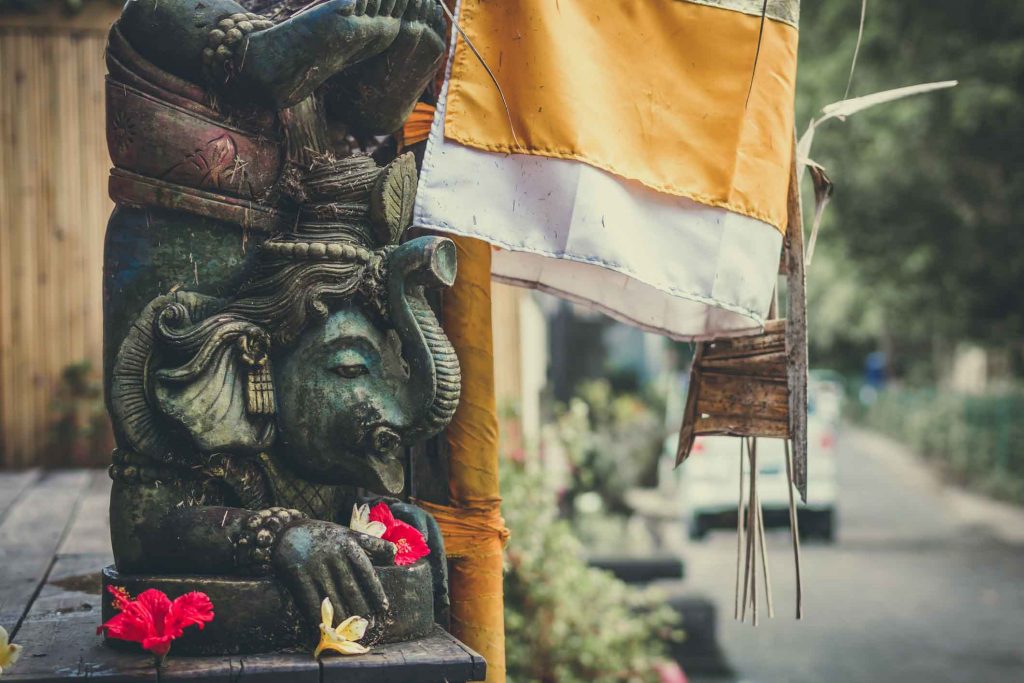
In saying the above, exploring temples in Bali, especially during festive seasons, is one of the best experiences you can have. Loud music and louder costumes lend themselves to massive festivities throughout entire villages that everyone and anyone seems to be a part of, some of which might even last a few days. For the quieter periods, you can visit some of the most unique temples to marvel at the detailing of the structures, pay your respects, and spend some time on self-reflection.
Note: To follow and respect their culture, any women who are on their period are not allowed to enter temple grounds, and everyone must wear a sashay and a sarong to enter most, if not all, temples. The entrances of most places will have an area to rent them if you don’t have them.
1. Tanah Lot (Tabanan, West Bali)

Tanah Lot is probably the most famed temple on the entirety of Bali, because of its close proximity to many of the main areas where visitors stay, and also because of its unique location jutting out from the island into the ocean.
Located just 45-minutes away from Kuta (you can take a taxi, it’s super cheap), it can be visited in just a few short hours, along with some exploration of the nearby village’s restaurants, shops, and cultural park often showcasing dance performances. Due to its popularity, expect to see a crowd on any given day. Also, be mindful that during high tide, waves make the rock walkway impossible to cross.
The best time to visit this temple would be just before sunset so that you can experience the sun’s glow as it descends over the horizon behind the beautiful temple with the waves crashing around you.
During the year, this temple becomes majorly festive on the holy day of Kuningan and on the temple’s anniversary which happens five days later (these dates are calculated on the 210-day Balinese calendar). The upcoming few temple anniversaries at Tanah Lot are: 9 January 2019, 7 August 2019, 4 March 2020, 30 September 2020.
Address: Jalan Raya Tanah Lot, Beraban Village, Kediri, Tabanan
How to get to it: The easiest and most convenient option would be to take a taxi out. Expect to pay around 200,000 Rupiah for a return trip to Kuta. You can also book a tour.
Hours: 7:00am – 7:00pm
More info here: Tanah Lot Temple
2. Uluwatu Temple (Uluwatu, Jimbaran)

Located on a southwest clifftop (where you can find the best beaches in Bali), Uluwatu is what you would typically see on Bali’s postcards depicting a temple against the stunning background of the ocean and the sunset. Based in Uluwatu, which is also a hotspot for surfers, it’s a great place to capture beautiful shots of historic structures against the blue of the ocean.
One of the most unique aspects of this temple is the distinct Balinese architecture, traditionally-designed gateways, and historic sculptures that you can view and marvel at when exploring it. There is a small forest nearby where hundreds of monkeys live, and some transcend to where visitors stroll, sometimes grabbing items off people, so beware!
Whilst you’re there, stick around for the Ramayana ballet (Kecak dance) which performs daily in an amphitheatre nearby during the golden sunset hours. Take some quick snaps and head there for some interesting cultural performances by the locals.
Every six months (according to the 210 month Balinese calendar), big temple anniversary celebrations are held at Uluwatu. Visitors must wear a sarong and a sash over appropriate clothing that are common when visiting temples. The best time to visit this is just before sunset, and then head to watch the Kecak dance performance from 6:00pm.
Address: Pura Uluwatu, Pecatu Village
How to get there: If you are on a moped scooter, take the bypass road to Nusa Dua and to Jimbaran, and then follow the ascending road to Uluwatu. However, it is recommended to hire a taxi for a return trip from anywhere within the main city.
Hours: 9:00am – 6:00pm (as a place of worship, it is open 24 hours)
Book a Tour: Sunset Tour (inc. Kecak Dance)
3. Besakih Temple (Karangasem)

Besakih is not so much one refined temple, but rather a grand structure encompassing different clan temples and multiple shrines, hence it’s nickname ‘Mother Temple of Bali’.
Located on the south-western slopes of Mount Agung, Besakih sits at an altitude of roughly 1,000m above sea level, and will take you pretty much an entire day if you want to explore the whole area. There are at least 86 temples which include the main Pura Penntaran Agung.
If you’re after a picturesque temple in a stunningly traditional setting, this would be your go-to place. It’s the holiest of the island’s temples, and sits in the middle of breathtaking rice paddy terraces, hills, upscale mountains, and water streams. Trees hang their branches to provide natural shade in some areas, and during sunrise and sunset, the almost eerie feeling in the air is offset by the feeling of contentment being in such a peaceful place.
Due to it’s extraordinarily high location, with many stairs leading up the sacred mountain to get to it, you will feel more spiritually in-touch than most other temples. There are more than 70 festivals and ceremonies held annually in addition to the sacred holidays based on the Balinese 210-day calendar.
The best visiting times would be early in the morning, or in the evening, as it’s much quieter during these times. You will need to wear a sarong and a sash, however, they are available for rent.
Address: Besakih Village, Rendang Sub-district, Karangasem District
How to get there: If you have a moped scooter, from Sanur, take the Kusamba Bypass to Klungkung. Head north through Klungkung and take the right-hand turn to Menanga to get to Besakih. The journey from Sanur shouldn’t take longer than two-and-a-half hours.
Hours: 8:00am – 5:00pm (as a place of worship, it is open 24 hours)
Entrance Cost: 60,000 IDR (4$)
4. Goa Gajah (Ubud)

Located just 6km outside of the main Ubud area lies Goa Gajah, which translates to Elephant Cave, although that’s where any ties to the animal are severed. This site is a special one for the history buffs, as it’s believed that the history of this temple was as unique as it is decorated. Filled with relics, carvings, caves, and fountains, this easily makes for a short 1-2 hour visit before heading off to your next destination.

Goa Gajah temple dates back all the way to the 11th century, and was believed to be a place for meditation. The entire area is made up of a main ground which is down a flight of stairs from the parking area, a ‘wantilan’ meeting hall, an excavated pool, a cave, and a line of various art and souvenir shops, as well as a light refreshment stand.
Inside the various structures are relics and carvings that indicate Hindu and Buddhism influences, with religious statues still standing guard. A suggestion as to how it got its name is that the stone figure inside the cave depicting the Hindu lord Ganesh, who features an elephant’s head, was used as inspiration.
Address: Bedulu Village, Jalan Raya Goa Gajah, Blahbatuh, Gianyar
How to get there: If you’re riding a moped scooter, from Ubud, head east approximately 3km towards Jalan Raya Goa Gajah.
Hours: 8:00am – 4:00pm
Entrance Cost: Adult – 15,000 IDR (1$)
5. Lempuyang Temple (East Bali)
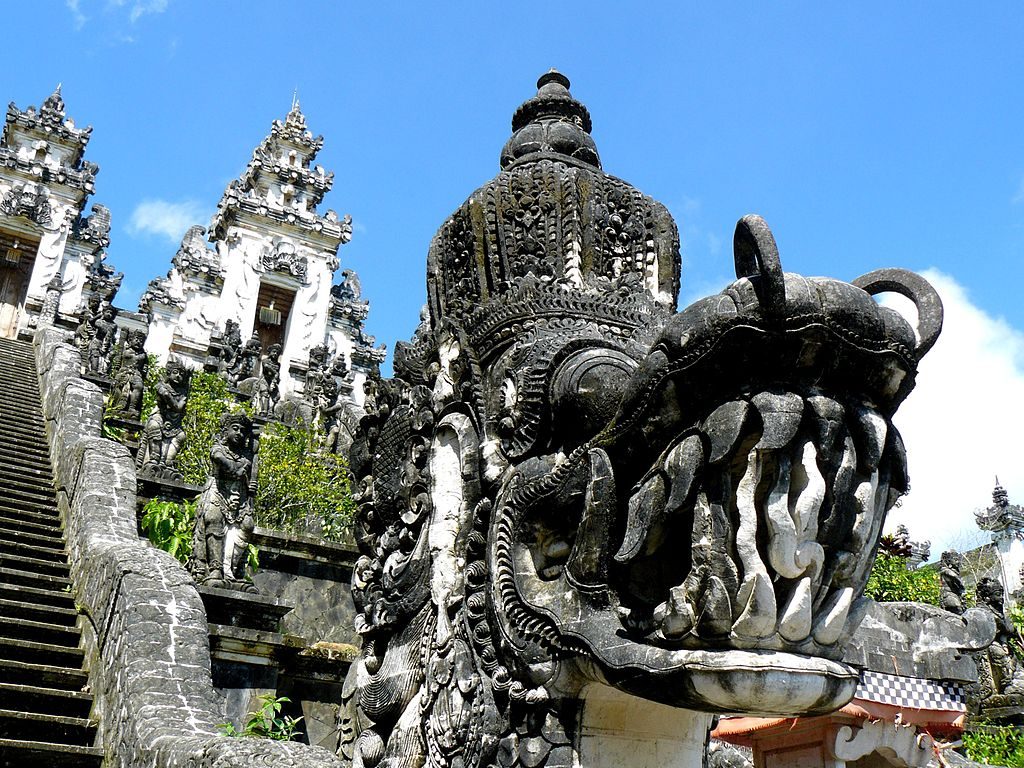
Considered one of the oldest Balinese temples (widely considered to pre-date the majority of Hindu temples on the island), Lempuyang is not to be missed for those who enjoy working for their prize.
Located at 1,175m above sea level on Mount Lempuyang, to reach the top where the main temple lies, you will need to climb over 1,700 steps (to put that into perspective, it will take the average climber roughly two hours to complete that ascent).
However, don’t despair, because along the way there are several attractions to stop by, take a rest, and appreciate, including other temples groups of grey long-tailed macaques monkeys that live in the surrounding forests.
When you get to the top, prepare to be wowed with views of multiple mountains stacking up behind one another, all the way to Mount Agung, Bali’s highest peak and home to the Besakih temple. Due to the strenuous climb, there will be hardly any other visitors at the top. If you’re not the type to climb 1,700m for fun, you can still enjoy the grand Puta Penataran Agung temple at the foot of the mountain. It features an impressive sight with towering dragon staircases.
If you’re after that one particular photo for Instagram, head to the ‘Gateway to Heaven’.
How to get there: From Seminyak, it could take anywhere between 2.5 to 4.5 hours to drive to, so it’s best to hire a taxi or a private driver to do the trip to and from the city area.
Hours: 7:00am – 4:00pm
Cost: 10,000 IDR (<1$) for sarong hire, and then a donation fee for entrance (up to you, but generally around 20,000 IDR (>1$))
6. Gunung Kawi Temple

Whilst Gunung Kawi is one of the lesser visited temples in Bali, but that doesn’t take away from its sheer natural beauty and unique architectural structuring. In fact, due to the relatively low number of tourists visiting this site, it makes for a peaceful sightseeing trip to see one of Bali’s most decorated temples located at the bottom of a green valley.
The temple is absolutely overflowing with luscious green fauna, gorgeous blooms and towering trees. The main site of this temple overlooks the sacred Pakerisan River, which is the same river that flows through Tirta Empul located slightly up north. Due to the close proximity of the temples, it’s definitely possible to visit them both on the same day, within a few hours. The temple itself comprises of a courtyard displaying Hindu shrines and small stone caves that serve as meditation sites.
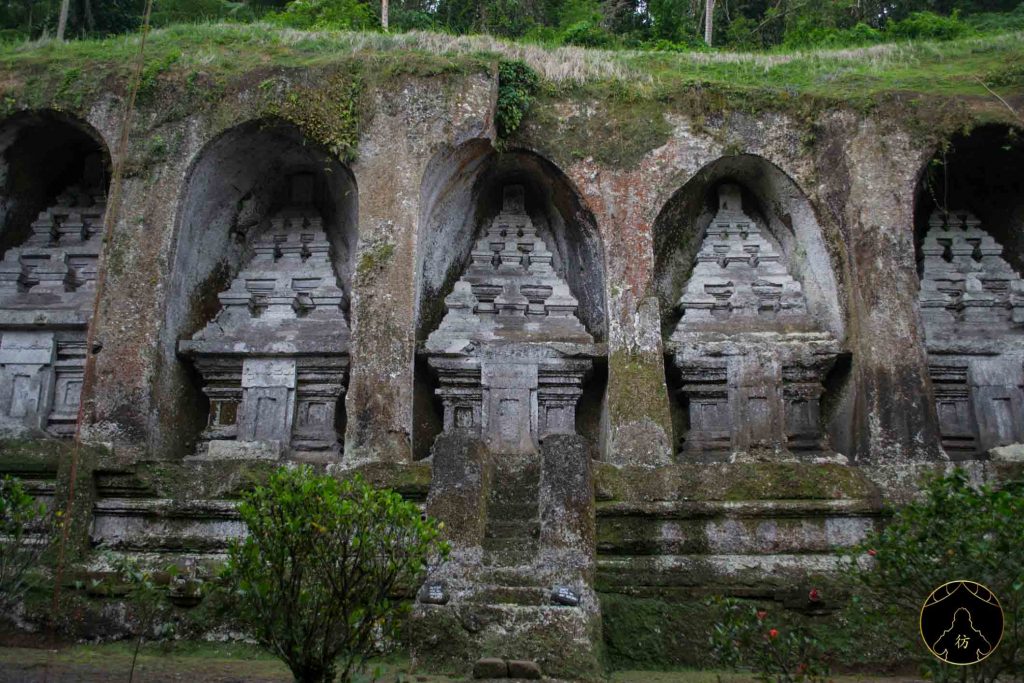
One of the most impressive features of this temple are the five monuments that are carved into the cliff face on the temple grounds. The carvings are 8m tall each, and are said to be dedicated to a past Balinese king name Udayana and his four wives.
A few hundred metres from the temple is the popular Jalan Raya Tamapksiring route, which goes past small art shops and food carts, and if you continue walking along it, you will pass the river, lush paddies and green valleys.
If you’d like to coincide your visit with a major celebration, the following upcoming dates are anniversaries of the temple: 26 August 2018, 14 September 2019, 2 September 2020.
Address: Banjar Penaka, Tampaksiring, Gianyar, Bali 80552, Indonesia
How to get there: Gunung Kawi is located roughly 30 minutes from Ubud, to the northeast of the city.
Hours: 7:00am – 5:00pm
Entrance Cost: 15,000 IDR (1$)
7. Taman Ayun Temple

A quiet and peaceful temple located in the village of Mengwi, this architectural masterpiece features courtyards brimming with stone structures, expansive garden landscapes, and ponds that host impressive lotus flowers and schools of fish. The most notable features of Taman Ayun are the towering tiers from the temple shrines. Taman Ayun, unsurprisingly, translates to ‘beautiful garden’.
There are a few courts to explore on this temple site, however, make sure you spend a little more time in the fourth (last) court. It’s considered the most sacred of all, and ranks the highest of all the courts. Whilst the intricately decorated central gate is only open during ceremonies, you can use the east gate for daily access. The temple also shares the same anniversary day as the famed Uluwatu Temple.
Address: Jl. Ayodya No.10, Mengwi, Kabupaten Badung, Bali 80351, Indonesia
How to get there: If you’re driving or have a moped scooter, follow the main road north from Denpasar along the common Jalan Kapal thoroughfare towards Bedugul. Upon reaching Mengwi, the landmark can’t be missed.
Note: A trip to Taman Ayun Temple is usually included in a longer itinerary for journeys either up to central or northern Bali.
Hours: 9:00am – 4:00pm
Cost: 3,000 – 4,000 IDR (0.3$)
8. Ulun Danu Beratan Temple (Bedugul, Tabanan)

Located in Bali’s central highlands near Beratan Lake, this beautiful landmark temple is a feast for the eyes. On certain days and generally in the early hours of the morning, the temple, which is built right on top of the water, appears to be floating. The smooth reflection of the wooden Beratan Temple in the still water will bring peace and tranquillity to anyone willing to make the trek out there. Coupled with the green mountainous background, and it’s like a scene out of a movie.
The entire Bedugul area where it is located is actually a popular weekend and holiday retreat for locals, and the cool atmosphere of the Bali uplands have made it a favourite sightseeing spot for locals and tourists alike. For those who want to take more than just scenic shots, you may hire traditional jukung outriggers to tour the lake as well as motorised boats for a quicker ride. Activities close-by on the Beratan Lake include parasailing, jet-skiing, and fishing.
The best time during the day to visit would be between 9:00am – 10:00am to allow the morning fog to disappear.
Address: Danau Beratan, Candikuning, Baturiti, Tabanan Regency, Bali 82191
How to get there: This temple is located quite far from major cities. It’s around a 2.5-hour drive from Kuta or Seminyak, and 1.5 hours away from Ubud. The most common, and to be honest the easiest and most convenient, way to get to Ulun Danu Beratan Temple is to book a tour or to flag a taxi and head there on a meter.
Hours: 8:00am – 6:00pm
Cost: Adult – 50,000 IDR (4$)
Book a tour: Bali World Heritage Tour
9. Pura Taman Saraswati Temple
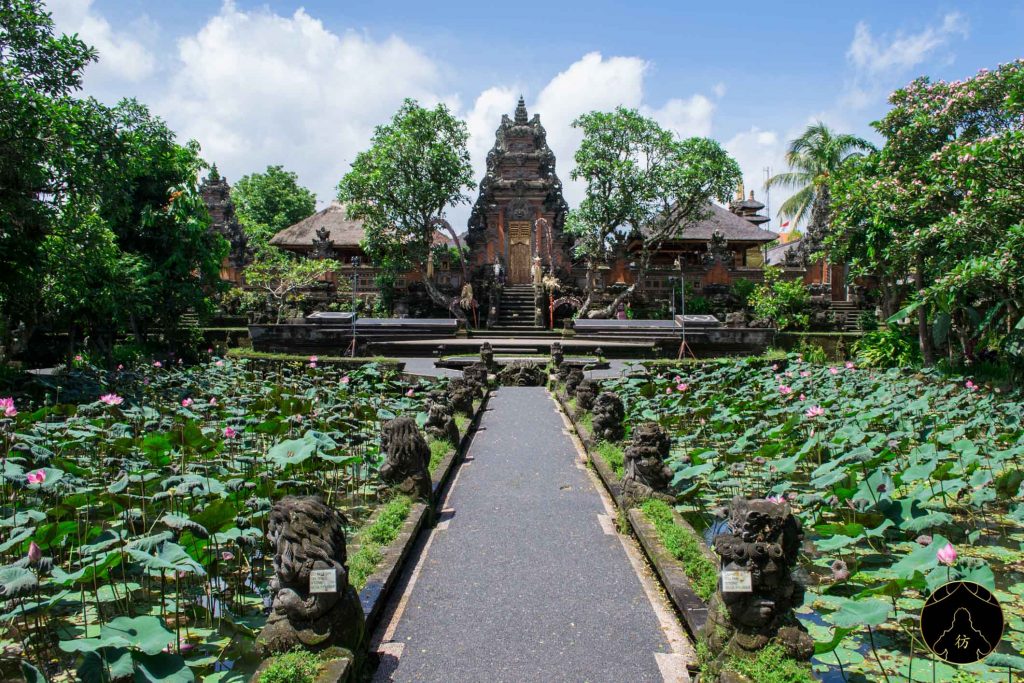
Considered one of the most beautiful water temples in Ubud, this temple is also a great sightseeing spot as it’s quite central and can be reached whilst strolling through Ubud town. Classic Balinese architecture fuses with nature to present a gorgeous temple surrounded by ponds filled with blooming pink lotuses, soft green moss growing on the stones lining the footpaths, and various types of trees encompassing the area.
Unlike other temples, entry into this temple is free, however, for the best viewing spot of the lotus and the temple’s open stage (where regular traditional dance performances are held in the evenings from 7:30PM), head to the on-site Café Lotus for a minimum cover charge of 200,000 IDR ($15USD) and nab a table.
Throughout the day, you can enter the temple through it’s amphitheatre and spend some time leisurely admiring the architectural features alluding to Hindu history and religion, and bask in the calming atmosphere.
Address: Jalan Kajeng, Ubud, Kabupaten Gianyar, Bali 80571, Indonesia
Hours: 7:00pm – 5:00pm
Cost: Free
10. Tirta Empul Temple (Gianyar, Central Bali)

Tirta Empul is actually a national cultural heritage site. Dating back to 960 AD, it is believed that it came to existence during the rule of the Warmadewa Dynasty. The name translates to ‘holy water spring’, and this is dedicated to the water feature located within the temple in which the water from the spring flows directly into various purification baths, pools, and fish ponds.
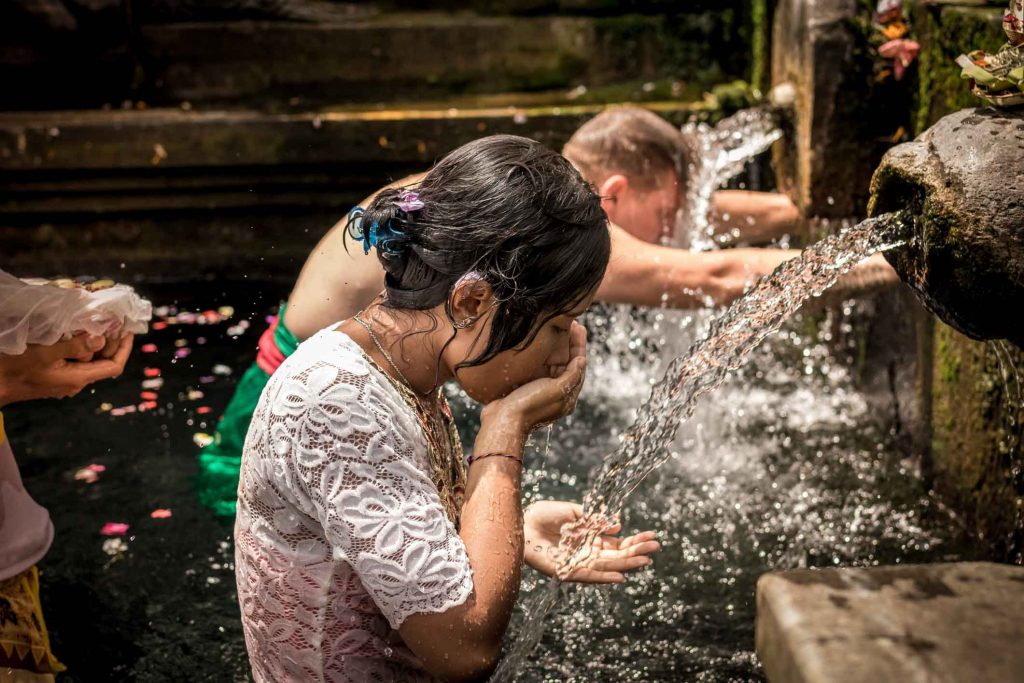
When you first visit Tirta Empul, you will come past a lush garden and pathway lined with statues and tropical plants, after which you will enter through a ‘candi bentar’ (temple gate) and be presented with a vast courtyard hosting the bathing pools and a meeting hall.
One of the highlights of visiting this temple may be witnessing people proceeding through the purification bathing ritual in the Jaba Tengah area – it’s an interesting cultural ritual to be able to see firsthand. Some tours will allow you to participate yourself, but it is traditionally meant for pilgrims and devotees. Consult your guide (if you are there with one).
Give yourself maybe one hour to explore this temple sire. Also located at this temple is a parking lot with art markets and rows of shops selling souvenirs, and some food stalls selling local food, snacks and refreshments.
Address: Manukaya Village, District of Tampaksiring, Gianyar, Central Bali
How to get there: If you have a car or a moped scooter, the village is located 30-minute away from Ubud. However, most tours will pick you up from your accommodation and take you to and from.
Hours: 9:00am – 5:00pm
Cost: Adult – 15,000 IDR (1$)
Spending time to appreciate the architectural and religious phenomenon’s that are the Bali temples is truly somewhere to be excited about. The effort and detail taken by the Balinese people to preserve and maintain the temples to their current glory today is outstanding, and something that should be experienced by anyone and everyone heading to Bali who wants to see what makes up a massive portion of their culture.

